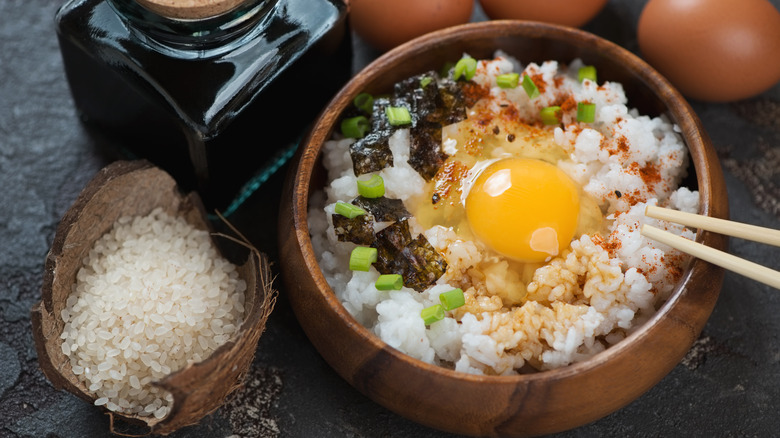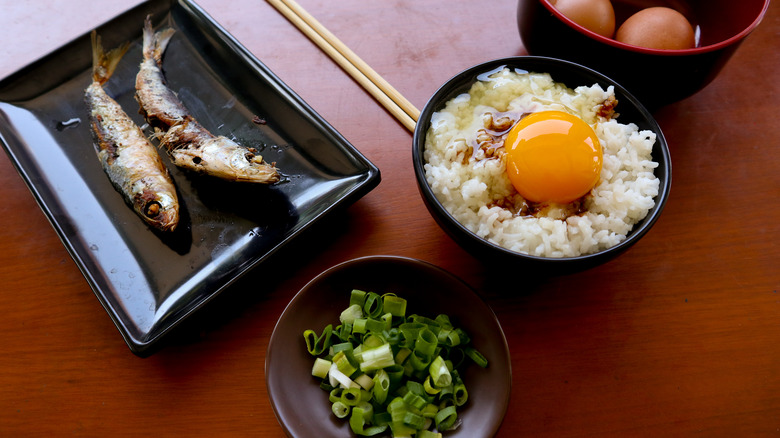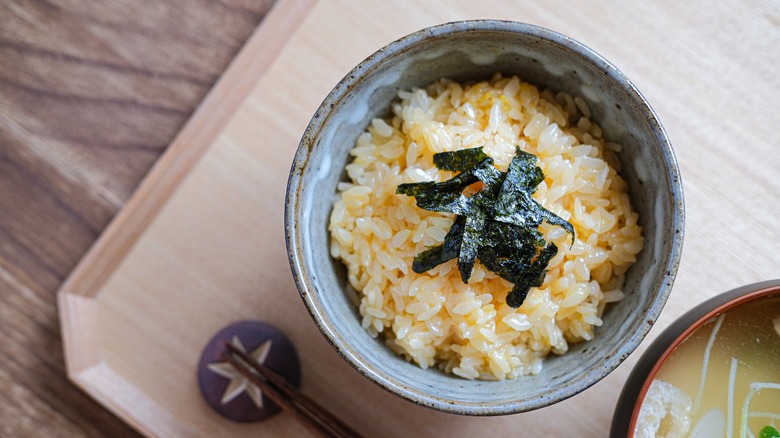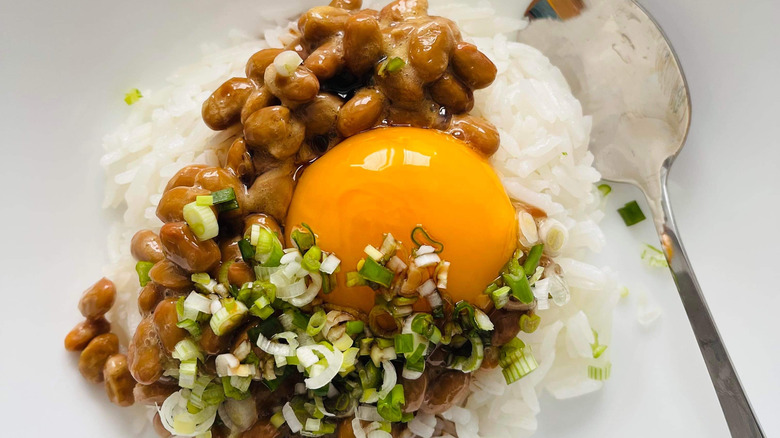Tamago Kake Gohan: A Japanese Egg And Rice Tradition
If there is one ingredient that is ubiquitous in Japanese cuisine, it's egg. In fact, the Japanese consume more eggs per capita than any other country, even egg-loving Americans, at 320 eggs (per The World Population Review). The egg shows up in just about any type of food you can find in the island nation. Whether it is home-cooking classics like the oyakodon – or the tamago sushi you can find in sushi bars, chances are you will be eating some kind of egg dish if you visit Japan.
However, among all the ways you can eat an egg in Japan, none is simpler than the humble tamago kake gohan. Literally translated as "egg on rice," this simple dish has just three ingredients: a raw egg, a bowl of hot rice, and soy sauce for seasoning. When mixed together with chopsticks, the rice is coated with the salty umami of soy sauce and the richness of the egg, creating the ultimate Japanese comfort food.
The egg and Japanese cuisine
Historically, the Japanese people did not consume eggs for religious reasons. It would not be until the Edo period in the 17th century when eggs began to enter the Japanese diet as an expensive delicacy. Almost two centuries later, tamago kake gohan was first mentioned by Ginko Kishida (1833-1905), who was a pioneering reporter during the Meiji Era (1868-1912) and the co-author of the first Japanese-to-English dictionary. He claimed to have invented the dish, and his magazine article about eating raw eggs on rice helped spread the practice across the country.
Tamago kake gohan would have remained a humble home-cooked dish until companies started to develop and market specialized soy sauces to complement the flavors of the egg and rice in the 2000s, sparking renewed interest. Today, you can find expensive "designer" eggs that come from chicken with specialized feeds, alongside dozens of soy sauces in Japanese markets formulated to be consumed with raw eggs on rice. You can also find many restaurants throughout Japan that serve only tamago kake gohan, with some of them so popular that you will find yourself waiting quite some time before being seated.
Making your own tamago kake gohan
If you are interested in trying this Japanese comfort food for yourself, you need eggs, rice, and soy sauce. Since the egg will be consumed raw, you need to find the best eggs possible to avoid bacteria contamination. You can find eggs flown in from Japan in some specialty markets, but you can also get pasteurized whole eggs, which go through a process to eliminate any harmful bacteria. Failing that, you can minimize any risk by simmering a whole egg for a minute or two. While the texture will not be identical to a raw egg, almost all the egg white and yolk will still be liquid and ready to be mixed.
In terms of rice, short-grain sushi rice is the norm for tamago kake gohan — although medium-grain rice, such as calrose rice, is also acceptable. Use high-quality Japanese soy sauce since the dish is so simple that the quality of each ingredient can make or break it.
Once you have a bowl of steaming hot rice, crack the egg on top of the rice and drizzle a bit of soy sauce on top. Pierce the yolk and mix thoroughly, then taste and season with more soy sauce if necessary. Although purely great on its own, you can add shredded nori seaweed or furikake (a condiment with sesame seeds, seaweed, and other seasonings) on top for extra flavor and texture. Serve with sweet and salty Japanese pickles on the side.
The science of eating raw eggs
To those who live outside of Japan, it might be unfathomable to consume raw eggs as they are, given the warnings we have all heard about foodborne illnesses that come from eating raw and undercooked eggs. However, thanks to the strict food safety regulations that govern the production of eggs in Japan, it is estimated that the infection rate of Salmonella, the most common bacteria from uncooked eggs, is about 0.0029%(per YouTube). Therefore, you are highly unlikely to get sick from a raw Japanese egg.
Tamago kake gohan also fits the Japanese palate in another way. Although not uncommon in Western cuisine, slippery and slimy textures are a regular part of Japanese food. For example, natto, a slimy fermented soybean, is a common feature in Japanese breakfast, often mixed with rice. Therefore, the slippery texture of raw egg whites is a welcome feature in Japan. In fact, lightly mixed raw eggs are served as a dip for sukiyaki, a Japanese hot pot of beef and sweet soy. You can also find raw eggs served with other rice dishes, including gyudon, a type of beef and onion rice bowl that is a popular Japanese fast food.




